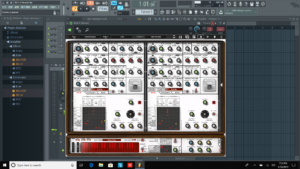The folks at XILS-lab continue to amaze with realistic synth plugins emulating classics from those halcyon days of analog yore. We previously reviewed their PolyM, a great take on the Polymoog. This time out, our eyes and ears are trained on XILS-4, inspired by the setup of Tim Blake, legendary synth-master of those psychedelic spacerock Dadaists, Gong. Tim also played with Hawkwind, the other twin pillar of spacerock.
XILS 4 Features
- Two VCS3 Synths Working in Tandem
- 256 Step Virtual Analog Poly-Sequencer Also Modulates
- 12 Oscillators in Six Pairs, Two Noise Generators
- Two Filters and Four Envelopes and Two Virtual Joysticks
- Effects Include Chorus, Delay, Phaser, Spring Reverb
- Cascade Mode Lets Synth 1 Feed the Inputs of Synth 2
- Two Virtual Pin Matrixes Allow Over 1000 Connections
- Over 350 Presets Plus Support for XILS 3 Presets
- Stunning Sound Quality
- Supports Most Popular Plugin Formats for Windows and OS X
- Available for $179 from XILS-lab
XILS 4 has been kicking my ass for a few weeks, which likely delayed this review. It emulates a different type of synthesizer compared to PolyM, but all the same, the sound quality simply blows me away. XILS-lab knows what they are doing. Let’s dive in.
The Genesis of XILS 4
XILS-lab garnered massive praise for its XILS 3 plugin, which effectively emulates the legendary EMS VCS 3 synth of the late 60s, while adding a second modulation matrix. Soon, the intrepid developers looked to expand the plugin into something greater. The prototype of the VCS 4 – essentially two connected VCS 3s – seemed like the perfect model for their new project.
Tim Blake soon entered the fray. His Crystal Machine modular synth connected two EMS Synthi units, the successor of the VCS 3, following a similar model as the never-released VCS 4. I reached out to Tim for comments on his contribution to the XILS 4 project.
“Xavier (Oudin, XILS-lab’s chief) has been making great plugins! I really liked the first run of his XILS (3) and suggested to him about looking at the modified Crystal Machine one. Not all my mods were taken into account, but some were. I think the most important mods I brought, Oscillator Sync and PWM work well together” said Blake.
Tim Blake’s influence on the synthesizer world cannot be overstated. Check out his work with Gong (especially the Radio Gnome Invisible trilogy), and his solo albums, Crystal Machine and Blake’s New Jerusalem. He ranks with Edgar Froese and Klaus Schulze as three seminal electronic music pioneers. Obviously, he’s also a big influence on my own musical projects, Church of Hed and Quarkspace.
Visit the Tim Blake Facebook page or website for more information.
It’s Like Two VCS 3s All Rolled Into One!
The meat of the XILS 4 interface lurks within its two VCS 3 synths with the addition of a third panel for the poly-sequencer and other modules. A simple button click navigates between the three. Each synth panel matches the look of the original, with the unique EMS modulation matrix also included.
XILS 4 is a fully modular synth, so no connections are hard-wired. You must embrace the matrix! Actually there are two matrixes for each synth: one 16×16 main matrix, and a 15×15 extended matrix. A tab interface lets you display either or both.
A similar tabbed interface exists on the sequencer panel. This lets you access effects, envelopes, LFOs, inputs, and the sequencer itself. Pretty much every parameter is available on either matrix. The extended version lets you add some of the more esoteric parameters using a drop down menu, for example, the those supporting the sample and hold module.
With such a complex interface, the learning curve for XILS 4 is greater than other synth plugins as are its rewards. Simply put, it’s worth your time.
A Copious Amount of Presets to Inspire Your Patch Design
Familiarity with the excellent iVCS3 iOS app made exploring XILS 4 an easier process. Simply peruse the patch library to get an idea for the massive range of sounds. XILS-lab also provides a collection of tutorial patches to help you design your own sounds.
The new (as of version 1.5) patch library also warrants mention. It uses a similar style as other synth plugins, like Massive, where you search for patches based on attributes, like Author, Style, Type, etc. It’s a useful design considering the large number of presets with XILS 4, as well as the ones you’ll soon create.
An Obviously Flexible Synth Architecture
Combining two classic matrix synthesizers with a sequencer and other modules makes XILS 4 a perfect introduction to the world of modular synthesis. Sure, it doesn’t provide the flexibility of a full hardware Eurorack system or a virtual equivalent, like VCV or Reaktor 6. Still, it’s a learning opportunity being able to combine and sync the two synths, not to mention the extra modules, most notably the Sample and Hold and Voltage Processor.
Each synth sports three oscillator pairs, with a host of waveshaping and sync options. You are even able to sync oscillators between the two virtual VCS 3 units. Noise generators, ring modulators, and flexible filters combine to generate a gritty and powerful sound.
The versatile envelopes support both ADSR and trapezoidal formats. One envelope per synth is hard-wired to its VCA. Two extra envelopes are also available. Use them as is your wont using the matrix connections.
XILS 4 can also be used as a plugin effect. Input signals, which are sent to the first synth, get their own collection of modules, including transient and envelope followers. A pitch tracker extracts a tonal signal from the input; letting you route it to the oscillators or anywhere else within the matrix.
I plan on exploring this functionality more in the future. Ideas are percolating.
The keyboard and sequencer each get their own modulation matrix. XILS 4’s sequencer is especially powerful, letting you construct six-track sequences able to modulate synth parameters in addition to the standard note and gate triggers.
You know the first thing I did with the sequencer was change it to 10-steps. It’s all about those odd time signatures, folks.
Sound Quality That Shakes the Rafters
Just like PolyM, XILS 4 offers stunning sound quality. It holds its own in my studio, easily sharing sonic space with the Moog Sub 37 and Make Noise 0-Coast. The realistic sound puts XILS-lab at the pinnacle of those synth plugin makers specializing in vintage instruments.
Once again, make it a point to spend significant time exploring the patch library. You get an idea of the possibilities for mayhem; while also learning a bit about EMS’s unique take on modular synthesis. With a bit of time and effort, creating your own patches becomes second nature.
XILS 4 ranks near the top of any synth plugin in our library. It provides a great emulation of the prototype VCS 4, while also being inspired by Tim Blake’s Crystal Machine. And if you don’t take my word on it, listen to the opinion of electronic music legend, Jean-Michel Jarre:
“My 2 favourite analog synths are probably the VCS 3 and the Synthex. So when I heard that a company was releasing a software version, I was quite cautious. Today the XILS 4 is one of my favourite plugin! I find the same excitement working with it, (as) with the original, plus lots of other features: 2 VCS 3, interconnected sequencer, etc. The sound is great and it is one of the best in the market for experimenting (with) new ways of creating sounds!” Enough said!

